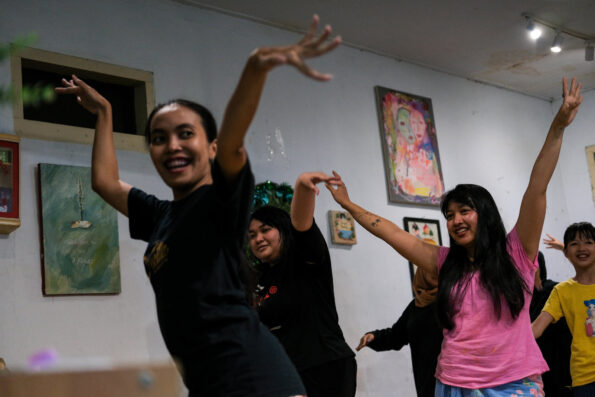
BUENOS AIRES, ARGENTINA – Bernabé “Gardelito” Ferreyra dances several colorful tango steps on an old sidewalk in Buenos Aires, the capital of Argentina. He dances alone, with his hands hugging the waist of an invisble partner.
“The tango for me is a passion,” the 78-year-old says in Spanish. “A reason for living.”
The wall behind him displays his story as a street artist painted in lime. The images detail a career that has taken him to Colombia, England and even Japan.
Despite his age, Ferreyra still dances with ease. Soon, he leaves his imaginary partner and picks up his guitar.
Standing on a plastic crate, he begins to sing as he plays. He belts out the song smoothly, hardly moving his lips. His sky-blue eyes reveal the tenderness of this local legend, dressed in a fitted suit that has lost its blue color. He loses his gaze among the people who pass by on the street, some depositing bills through the slot of a tin can.
Ferreyra say that when he sings, he feels like Carlos Gardel, the famous Argentine tango singer and composer from the 1920s and 1930s. Gardel died in an accident in 1935 but remains the emblem of tango here.
The lyrics of tango music and Gardel’s songs in particular tell stories of hopelessness and despair, of women loved and lost and of love for one’s childhood home. The rhythm of tango is melancholy and sensual. It’s sung with a sullen expression and danced with romantic insinuations.
“I am a street artist,” Ferreyra says. “I don’t receive anything for singing, only the collaboration with those who listen.”
Ferreyra was just 8 years old when he began to sing in his native city, Mar del Plata, located 250 miles south of Buenos Aires. He says that Gardel used to appear to him in his dreams and named him as his artistic successor, passing along his lyrics to him.
Ferreyra then traveled to Buenos Aires to fulfill his legacy. He says a woman who knew Gardel personally even gave him some of his clothing.
“I save everything,” he says. “I have the tie and an overcoat from Gardel.”
Ferreyra lives alone. He doesn’t have any family. He travels an hour from his house in the suburbs to perform several times a week in the neighborhood of San Telmo, the oldest neighborhood in Buenos Aires.
He starts performing at 10 a.m. after unpacking his things from a small, black bag: a speaker, a microphone, a music player and pages from magazines featuring his name. He performs until 6 p.m., usually earning about 600 pesos ($130) throughout the day.
Ferreyra shares the stage with several other street artists. Only three meters away from his improvised stage, a puppeteer gives life to a marionette depicting a drunk man dancing the tango beneath a streetlamp. Farther in the distance, a living statue of Gardel tips his hat every time someone gives him a few coins. For all of them, Ferreyra is a legend in the world of street art.
Osvaldo Bó says that when he began performing as a street dancer in San Telmo more than 40 years ago, Gardelito was already a well-known figure.
Bó and his wife, Blanca “Pochi” Acebo stand on a square, wooden stage on a street corner. An umbrella shields them from the sun. Both are 73, though Acebo likes to add that she is a few months older. They have been dancing together since they were 17.
“Two people give birth to the tango, and two people finish it,” Bó says. “We began dancing, with Pochi, when we were 17, and the tango is our life.”
He says that dancing in San Telmo is always the most special.
“We have traveled a lot, bringing the tango everywhere,” he says. “But the most beautiful is waking up on Sundays at 9 a.m., getting dressed while drinking some mate and coming to our corner.”
Bó and Acebo never miss their date in the historical neighbhorhood, no matter the weather.
“Even when it rains, in some moment of the day, it stops and then we dance,” Bó says.
Bó says that he and his wife are owners of the traditional tango, their bodies and cheeks pressed together, unlike the youth today who take longer steps and leave space between their bodies.
“We mark an entire period,” he says. “The youth who dance today have elasticity, elongation and speed. But the tango is a feeling that dances, and doing it with a woman whom you love is a pleasure.”
As Acebo takes a break in a nearby chair, Bó approaches the dance floor, which wobbles underneath his feet. He holds the hand of the spare dancer, Viviana Ayala, who wears a tight, red dress that shines like a polished guitar. Bó hugs her with a mischievous look on his face as Acebo looks on without jealousy, knowing from decades of experiences that it’s only an artistic number.
“She is a good person,” Acebo says of Ayala. “It’s been a long time that she’s been working with us. She helps me because sometimes I can’t dance so much. So she dances with Osvaldo while I rest a little.”
As the crowd concentrates on the stage, Acebo finally stands up and caringly touches Ayala’s neck to replace her in her husband’s arms. Together, the couple dances the tango with the expertise of a pair that has been dancing together all their lives.







